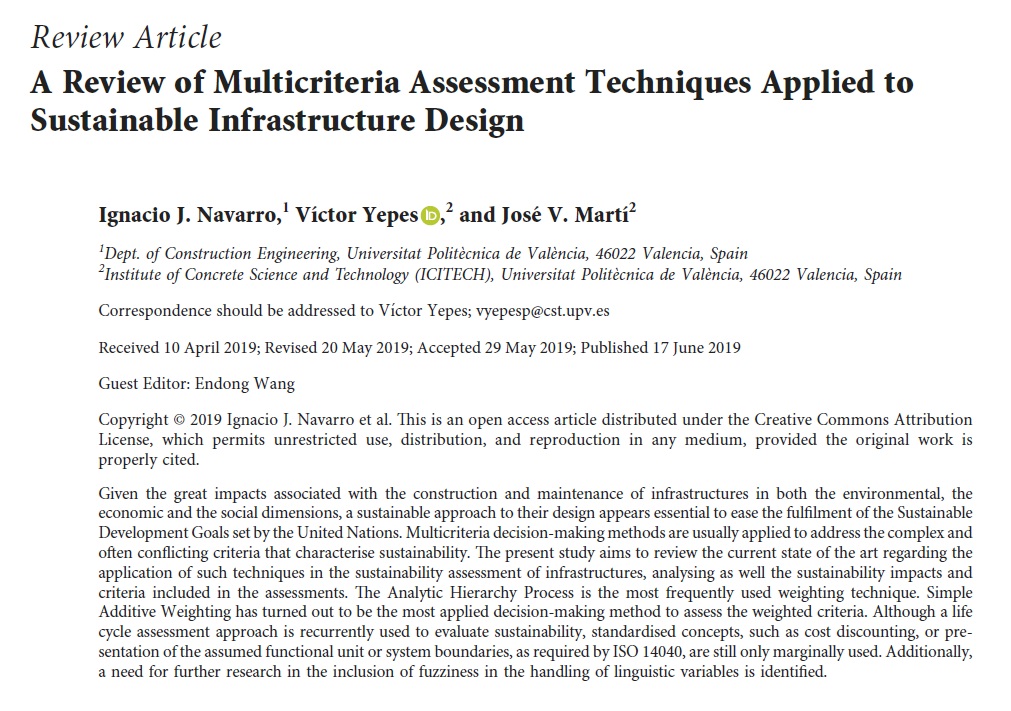 Acaban de publicarnos un artículo en la revista Advances in Civil Engineering (revista indexada en el JCR) sobre la revisión de las técnicas de valoración multicriterio aplicadas al diseño sostenible de infraestructuras. El trabajo se enmarca dentro del proyecto de investigación DIMALIFE que dirijo como investigador principal en la Universitat Politècnica de València.
Acaban de publicarnos un artículo en la revista Advances in Civil Engineering (revista indexada en el JCR) sobre la revisión de las técnicas de valoración multicriterio aplicadas al diseño sostenible de infraestructuras. El trabajo se enmarca dentro del proyecto de investigación DIMALIFE que dirijo como investigador principal en la Universitat Politècnica de València.
Dados los grandes impactos asociados a la construcción y mantenimiento de infraestructuras, tanto en la dimensión ambiental como en la económica y social, un enfoque sostenible de su diseño parece esencial para facilitar el cumplimiento de los Objetivos de Desarrollo Sostenible fijados por las Naciones Unidas. Un repaso a la bibliografía existente indica, por lo general, que se aplican métodos de toma de decisiones multicriterio para abordar los criterios complejos y a menudo contradictorios que caracterizan la sostenibilidad. El presente estudio revisa el estado actual de la técnica en la aplicación de dichas técnicas en la evaluación de la sostenibilidad de las infraestructuras, analizando también los impactos y criterios de sostenibilidad incluidos en las evaluaciones.
El artículo se encuentra publicado en abierto, y por tanto se puede descargar gratuitamente en el siguiente enlace: https://www.hindawi.com/journals/ace/2019/6134803/
ABSTRACT:
Given the great impacts associated with the construction and maintenance of infrastructures in both the environmental, the economic and the social dimensions, a sustainable approach to their design appears essential to ease the fulfilment of the Sustainable Development Goals set by the United Nations. Multicriteria decision-making methods are usually applied to address the complex and often conflicting criteria that characterise sustainability. The present study aims to review the current state of the art regarding the application of such techniques in the sustainability assessment of infrastructures, analysing as well the sustainability impacts and criteria included in the assessments. The Analytic Hierarchy Process is the most frequently used weighting technique. Simple Additive Weighting has turned out to be the most applied decision-making method to assess the weighted criteria. Although a life cycle assessment approach is recurrently used to evaluate sustainability, standardised concepts, such as cost discounting, or presentation of the assumed functional unit or system boundaries, as required by ISO 14040, are still only marginally used. Additionally, a need for further research in the inclusion of fuzziness in the handling of linguistic variables is identified.
REFERENCIA:
NAVARRO, I.J.; YEPES, V.; MARTÍ, J.V. (2019). A review of multi-criteria assessment techniques applied to sustainable infrastructures design. Advances in Civil Engineering, 2019: 6134803. DOI:10.1155/2019/6134803



